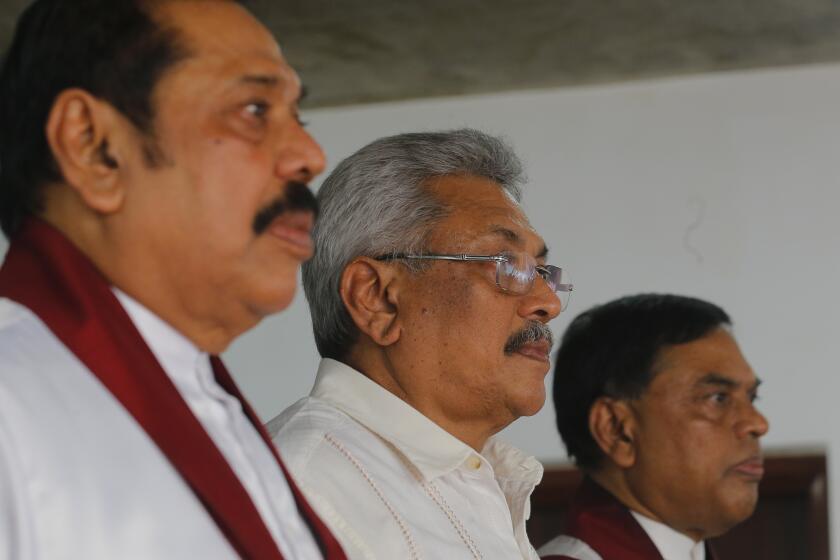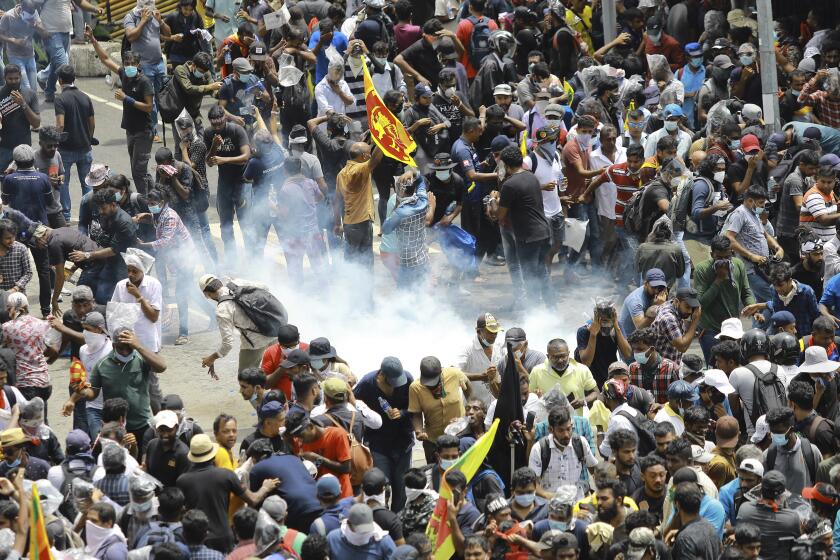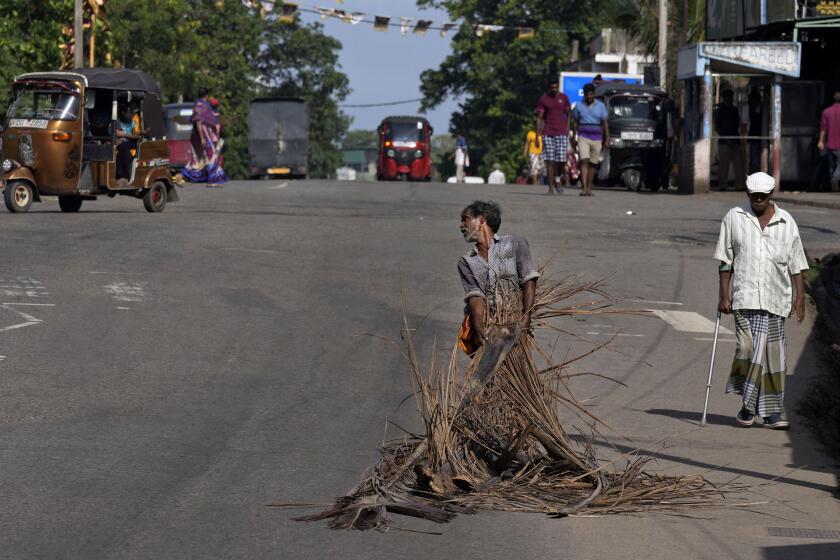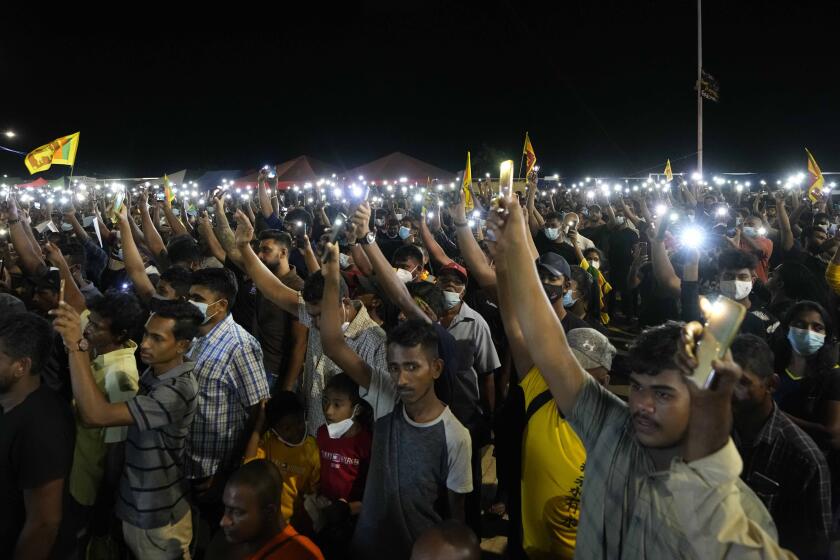After their president flees, Sri Lankans turn their anger on the prime minister
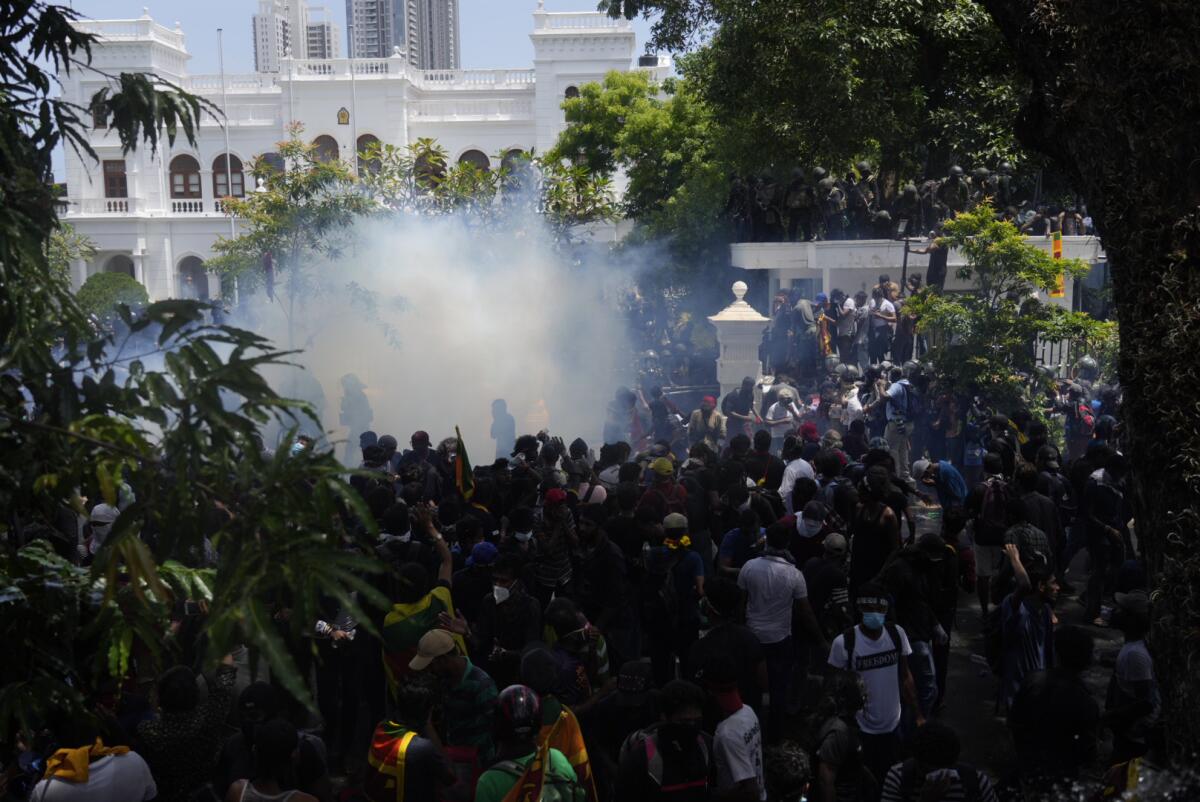
- Share via
COLOMBO, Sri Lanka — After Sri Lanka’s president fled the country early Wednesday, hours before his promised resignation, thousands of protesters demanded that the prime minster also step down, rallying outside his office and storming the compound, as they have other official buildings in recent days.
President Gotabaya Rajapaksa and his wife left aboard a Sri Lankan Air Force plane bound for the Maldives, the air force said in a statement. That appeared to only further roil passions in the island nation, which has gripped for months by an economic disaster that has triggered severe shortages of food and fuel — and now is beset by political chaos.
Thousands of protesters — who had anticipated that Prime Minister Ranil Wickremesinghe would be appointed acting president — rallied outside his office compound, and some scaled the walls as the crowd roared its support and tossed water bottles to those charging in.
Dozens could later be seen inside the building and standing on a rooftop terrace waving Sri Lanka’s flag. It was the latest in a series of government buildings that demonstrators have occupied in their quest for new leaders.
“We need both ... to go home,” said Supun Eranga, a 28-year-old civil servant in the crowd outside Wickremesinghe’s office. “Ranil couldn’t deliver what he promised during his two months, so he should quit. All Ranil did was try to protect the Rajapaksas.”
But Wickremesinghe, who declared a state of emergency, appeared on television to reiterate that he would not leave until a new government was in place — and it was not clear when that would happen. Although he fled, Rajapaksa has yet to resign, but the speaker of the Parliament said the president assured him that he would do so later in the day.
With one brother president, another prime minister and three more family members Cabinet ministers, it appeared that the Rajapaksa clan had consolidated its grip on power in Sri Lanka. But it is now unraveling.
Police used tear gas to try to disperse the crowd but failed. More and more demonstrators marched down the lane and towards the office. As helicopters flew overhead, some held up their middle fingers.
Eventually, security forces appeared to give up, with some retreating from the area and others simply standing around the overrun compound. Inside the building, the mood was celebratory, as people lounged on sofas and held mock meetings in conference rooms. Some wandered around as if touring a museum.
“We will cook here, eat here and live here. We will stay until [Wickremesinghe] hands over his resignation,” said Lahiru Ishara, 32, a supervisor at a supermarket in Colombo who has been a part of the protests since they kicked off in April. “There’s no other alternative.”
Protesters have already seized the president’s home and office and the official residence of the prime minister following months of demonstrations that have all but dismantled the Rajapaksa family’s political dynasty, which ruled Sri Lanka for most of the past two decades. At one point, protesters also burned Wickremesinghe’s private home.
Sri Lankan President Gotabaya Rajapaksa and Prime Minister Ranil Wickremesinghe have agreed to resign after protesters stormed their homes.
On Wednesday morning, Sri Lankans continued to stream into the presidential palace. A growing line of people waited to enter the residence, many of whom had traveled from outside the capital of Colombo.
Protesters have vowed to occupy the official buildings until the top leaders are gone. For days, people have flocked to the presidential palace almost as if it were a tourist attraction — swimming in the pool, marveling at the paintings and lounging on beds piled high with pillows. At one point, they also burned the prime minister’s private home.
At dawn, the protesters took a break from chanting as the Sri Lankan national anthem blared from speakers. A few waved the flag.
Nearby, Sithara Sedaraliyanage, 28, and her mother, 49, wore black banners around their foreheads that read, “Gota Go Home,” the rallying cry of the demonstrators against the president.
Sri Lanka’s debt-laden economy collapses as the island nation runs out of money to pay for food and fuel. What happened?
“We expected him to be behind bars, not escape to a tropical island. What kind of justice is that?” Sithara said. “This is the first time people in Sri Lanka have risen like this against a president. We want some accountability.”
Protesters accuse the president and his relatives of siphoning money from government coffers for years and Rajapaksa’s administration of hastening the country’s collapse by mismanaging the economy.
The Rajapaksa family has denied the corruption allegations, but Rajapaksa acknowledged that some of his policies contributed to the meltdown, which has left the island nation laden with debt and unable to pay for imports of basic necessities. The shortages have sown despair among Sri Lanka’s 22 million people and were all the more shocking because before the recent crisis, the economy had been expanding and a comfortable middle class growing.
“Not only Gotabaya and Ranil, [but] all 225 members of Parliament should go home, because for the last few decades, family politics have ruined our country,” said Madusanka Perera, a laborer who came to Colombo from the outskirts of the city. He has lost his job, and his father, a driver, can’t do his because of fuel shortages.
Breaking News
Get breaking news, investigations, analysis and more signature journalism from the Los Angeles Times in your inbox.
You may occasionally receive promotional content from the Los Angeles Times.
“I’m 29 years old,” Perera said. “I should be having the best time of life but instead I don’t have a job, no money and no life.”
The political impasse has only exacerbated the economic disaster since the absence of an alternative unity government threatens to delay a hoped-for bailout from the International Monetary Fund. In the meantime, the country is relying on aid from neighboring India and from China.
As the protests escalated outside the prime minister’s compound, his office imposed a state of emergency that gives broader powers to the military and police and declared an immediate curfew in the western province that includes Colombo. It was unclear what effect the curfew would have: Some ignored it, while many others rarely leave their homes anyway because of fuel shortages.
In his TV appearance, Wickremesinghe said he created a committee of police and military chiefs to restore order.
Thousands of Sri Lankans take to the streets a day after police opened fire at demonstrators amid the country’s worst economic crisis in decades.
The air force said in a statement that it provided an aircraft with the Ministry of Defense’s approval for the president and his wife to travel to the Maldives, an archipelago in the Indian Ocean known for its exclusive tourist resorts. It said all immigration and customs laws were followed.
The whereabouts of other family members who had served in the government were uncertain.
Former Prime Minister Mahinda Rajapaksa had been living at his home in Colombo after initially taking refuge at a heavily fortified Sri Lankan naval base when he was pressured to resign in May. Basil Rajapaksa, who holds dual Sri Lankan and U.S. citizenship, resigned as finance minister in April. His own attempt to leave the country wasn’t successful Tuesday.
Chamal Rajapaksa, their eldest brother, was the irrigation minister and resigned in April. Namal Rajapaksa, the son of Mahinda Rajapaksa, was sports minister and youth minister and resigned in April.
The coronavirus has spawned yet another super-contagious Omicron mutant that’s worrying scientists as it gains ground in India and other countries.
Sri Lankan presidents are protected from arrest while in power, and it is likely Rajapaksa planned his escape while he still had constitutional immunity. A corruption lawsuit against him in his former role as a defense official was withdrawn when he was elected president in 2019.
Sri Lankan lawmakers agreed to elect a new president next week but have struggled to decide on the makeup of a new government to lift the bankrupt country out of economic and political collapse.
The new president will serve the remainder of Rajapaksa’s term, which ends in 2024, and could potentially appoint a new prime minister, who would then have to be approved by Parliament.
“Gotabaya resigning is one problem solved, but there are so many more,” said Bhasura Wickremesinghe, a 24-year-old engineering student who is not related to the prime minister.
He complained that Sri Lankan politics had been dominated for years by “old politicians” who all need to go. “Politics needs to be treated like a job — you need to have qualifications that get you hired, not because of what your last name is,” he said.
More to Read
Sign up for Essential California
The most important California stories and recommendations in your inbox every morning.
You may occasionally receive promotional content from the Los Angeles Times.
